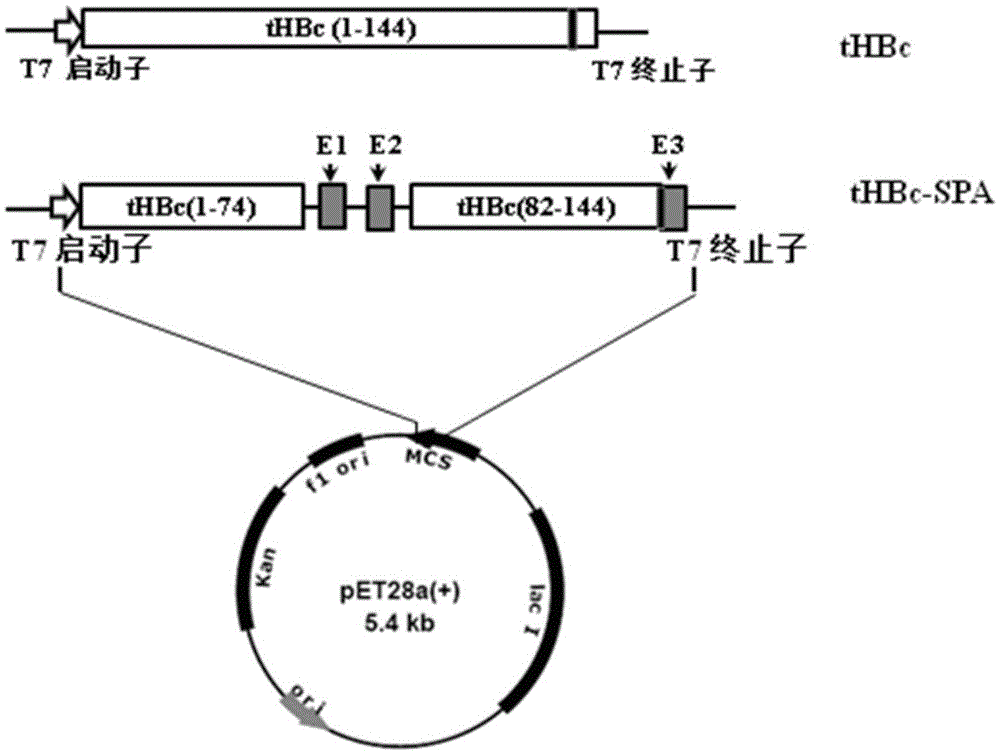Enteroviral chimeric virus-like particle vaccine and preparation method and application thereof
An enterovirus and chimeric virus technology, applied in the biological field, can solve problems such as weak immune response
- Summary
- Abstract
- Description
- Claims
- Application Information
AI Technical Summary
Problems solved by technology
Method used
Image
Examples
Embodiment 1
[0046] The construction of embodiment 1 enterovirus chimeric virus-like particle (VLPs) vaccine
[0047] 1. Synthesis of fusion fragment tHBc-SPA
[0048] The present invention obtains the fusion fragment tHBc-SPA through codon optimization and experimental screening. The fusion fragment tHBc-SPA is composed of nucleotides encoding 1-144aa (1-74aa and 82-144aa) of HBc and 208-222aa of EV71VP1 protein, 271-285aa of CA16VP1 protein and 248-263aa of EV71VP2 protein. Among them, 208-222aa of EV71VP1 protein and 271-285aa of CA16VP1 protein are linked by 9 amino acids (GGGGSGGGG) and the same 9 amino acids are introduced at both ends of the peptide to replace 75-81aa of HBc, and 248-285aa of EV71VP2 protein. 263aa is at the C-terminus of HBc1-144aa. The nucleotide sequence of the fusion fragment tHBc-SPA is shown in SEQ ID NO.2; the amino acid encoded by the fusion fragment tHBc-SPA can self-assemble into virus-like particles, and its amino acid sequence is shown in SEQ ID NO.1. ...
Embodiment 2
[0144] Example 2 Large-scale preparation and identification of enterovirus chimeric virus-like particle vaccine
[0145] 1. Large-scale preparation of enterovirus chimeric virus-like particle vaccine
[0146] 1) Large-scale induced expression of recombinant antigenic protein tHBc-SPA or tHBc
[0147] (1) Take the frozen engineered bacteria out of the -80°C refrigerator, thaw, transfer 0.1mL of the bacteria liquid to 5mL of LB medium (containing kanamycin and chloramphenicol), and rotate overnight at 37°C and 220rpm .
[0148] (2) The overnight culture was inoculated into 1 LLB medium containing kanamycin and chloramphenicol at a ratio of 1:100, and cultured with shaking at 37°C and 220rpm. To be cultured to the logarithmic growth phase (bacterial solution OD 600 value reached 0.6), IPTG was added to a final concentration of 0.2 mM, 37 ° C, 220 rpm rotating culture for 5 hours to induce protein expression.
[0149] (3) Transfer the induced culture to a 250 mL centrifuge tub...
Embodiment 3
[0173] Example 3 Functional Detection of Enterovirus Chimeric Virus-like Particles (VLPs) Vaccine
[0174] Experimental protocol
[0175] Seventy-eight female BALB / c mice aged 6-8 weeks were randomly divided into groups A, B, C, and D, with 13 mice in each group. Blood was collected from the tail of the mice before vaccination, and the serum was separated for antibody detection. The immunizations were designed according to the following: group A was injected with UV-inactivated EV71 (10 μg / monkey); group B was injected with tHBc-SPA (VLPs) at a dose of 10 μg / bird; The control group was PBS; immunized by intraperitoneal injection, each vaccine was immunized three times with an interval of two weeks; two weeks after the third immunization, blood was collected by docking the tail, and the serum was separated. After vaccination, the mice in each group were observed and weighed every day. Compared with the mice in the PBS-injected control group, the mice in the tHBc-SPA vaccine in...
PUM
| Property | Measurement | Unit |
|---|---|---|
| Diameter | aaaaa | aaaaa |
Abstract
Description
Claims
Application Information
 Login to View More
Login to View More - R&D
- Intellectual Property
- Life Sciences
- Materials
- Tech Scout
- Unparalleled Data Quality
- Higher Quality Content
- 60% Fewer Hallucinations
Browse by: Latest US Patents, China's latest patents, Technical Efficacy Thesaurus, Application Domain, Technology Topic, Popular Technical Reports.
© 2025 PatSnap. All rights reserved.Legal|Privacy policy|Modern Slavery Act Transparency Statement|Sitemap|About US| Contact US: help@patsnap.com



